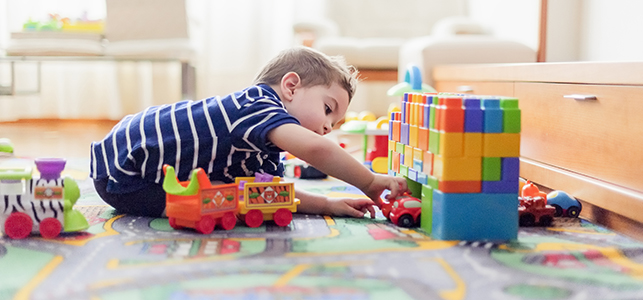
Parents often feel the need to fill our young children’s days with playdates, entertainment and academics. While each can be valuable, we shouldn’t underestimate the importance of independent play. After all, play is a child’s primary occupation and encourages creativity, problem-solving, self-discovery, attention and confidence.
Open-ended toys help facilitate independent play skills. These are toys that don’t have a specific purpose and do not require instruction for use.
When picking out an open-ended toy for a child, think of all the ways it could be used. Can your child build or stack with it? Can they connect, design or create with the toy? Can they pretend with it? These toys are often gender-neutral, timeless and can be used in different ways as the child grows.
Common open-ended toys include wooden blocks, Legos, animal figures, dolls, car tracks, train sets, art supplies, magnets, objects from nature, dress up materials, beading kits, Play Doh, and the list goes on. Don’t forget about household items, such as boxes to make a fort, or paper towel rolls to create a marble drop.
Open-ended toys encourage communication, exploration, creativity and problem solving. Kids have opportunities to develop autonomy and critical thinking skills by asking themselves:
What will it look like if I put this here?
Will this piece fit?
Can it be connected or stacked?
Can I imagine it as something else?
They can also develop and refine motor skills by learning to move their bodies in different ways to achieve a desired outcome. They may position their fingers differently to grasp a Lego because they learned it’s easier to pull apart from that position, or maybe they learn to slow their movement when stacking blocks because it helps balance the tower. Play with open-ended toys offers the freedom to explore different sensations and respond with newly learned motor movements, which ultimately helps with nervous system maturation.
As children feel more confident and comfortable in their capabilities, they may demonstrate improved focus toward the toy, greater attention and a wider variety of skills.
Independent play is important because it allows kids to feel capable in doing tasks on their own. Parents and caregivers can promote independent play by:
Children don’t need the most expensive or elaborate toys on the market. Some of the most fascinating toys are simple manipulatives or household objects that appeal to the senses.
Tools – I incorporate tools to scoop, pour and create with, like wooden tongs to pick up manipulatives or cups to practice pouring materials into containers.
Texture – Exposure to different textures can increase the child’s interest. I like to incorporate water play by using spray bottles and sponges to wipe away chalk drawings.
Movement – We practice a lot of coordination exercises in therapy, like performing animal walks and navigating obstacle courses. Parents and caregivers can bring the playground home by using boxes, laundry baskets or pillows to build their own jungle gym.
Play is the best way to facilitate learning, development and growth!